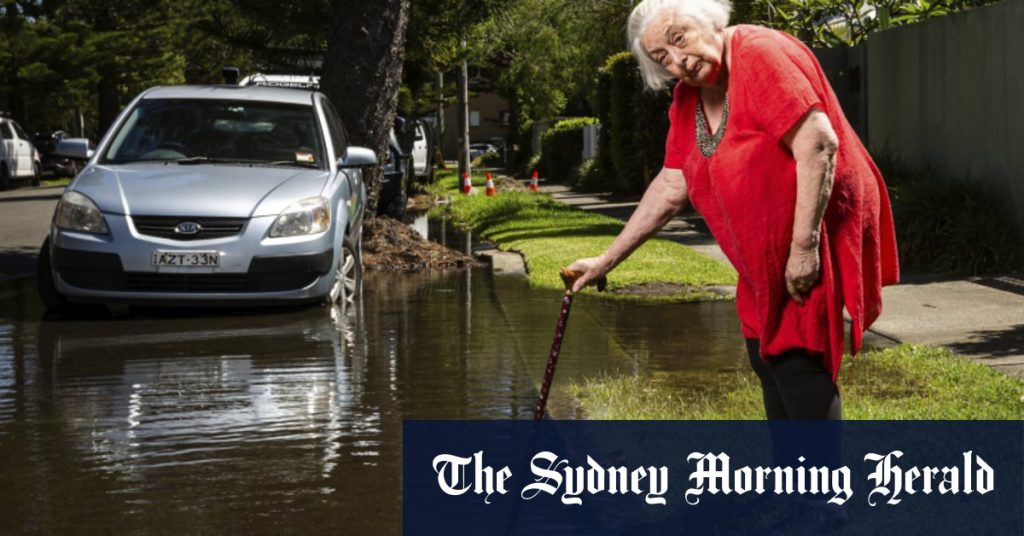The tranquility of Malvern Avenue, a serene street nestled two blocks from the picturesque Queenscliff Beach in Sydney’s northern suburbs, was shattered by an unexpected deluge. A burst pipe, originating from a nearby apartment complex, had unleashed a torrent of water onto the street, transforming it into a miniature waterway. For almost two weeks, residents endured the inconvenience of navigating around the persistent puddle, a constant reminder of the unresolved issue. Among those affected was 84-year-old Jane Hester, who found herself virtually stranded, unable to safely access her car due to the pervasive flooding.
Mrs. Hester’s plight encapsulated the frustration felt by many residents. The inundation had not only disrupted her daily life but also posed a safety hazard. The simple act of entering or exiting a vehicle became a precarious undertaking, requiring assistance to traverse the watery expanse that separated her front door from the street. Her appeals to both the Northern Beaches Council and Sydney Water seemed to fall on deaf ears, leaving her with a growing sense of exasperation and helplessness. The seemingly simple problem of a broken pipe had spiralled into a bureaucratic quagmire, leaving residents to grapple with the consequences. Mrs. Hester’s story, brought to light by the Sydney Morning Herald, became a symbol of the broader issue of accountability and responsiveness in addressing community infrastructure problems.
The publication of Mrs. Hester’s ordeal in the Herald acted as a catalyst, prompting immediate action from Sydney Water. Within hours of the story’s appearance, a team was dispatched to the scene, successfully stemming the flow of water and providing temporary relief to the beleaguered residents. While Sydney Water acknowledged that the responsibility for the repair ultimately lay with the property owner, they cited goodwill as the motivation for their intervention. This gesture underscored the impact of media attention in bringing about swift resolutions to seemingly intractable problems. A permanent fix was scheduled for the following Monday, offering a glimmer of hope for a complete resolution to the weeks-long saga.
The temporary fix brought a palpable sense of relief to Mrs. Hester, restoring a semblance of normalcy to her routine. Her Friday sketching group, followed by a Christmas lunch, offered a welcome respite from the preceding days of frustration. Armed with homemade crackers and a renewed sense of optimism, Mrs. Hester ventured out, noting the significantly reduced water flow and the evidence of recent excavation work. The seemingly insurmountable obstacle had been, at least temporarily, overcome.
This incident highlights several key aspects of urban infrastructure management. Firstly, it underscores the importance of timely responses to infrastructure failures, particularly those that impact the safety and well-being of residents. The delay in addressing the broken pipe not only inconvenienced residents but also created potential hazards. Secondly, it reveals the potential for bureaucratic entanglement when responsibilities for infrastructure maintenance are unclear or disputed. The apparent passing of the buck between the council and Sydney Water led to a frustrating delay in resolving the issue. Finally, it demonstrates the power of media exposure in holding authorities accountable and expediting solutions to community problems. The Herald’s coverage of Mrs. Hester’s predicament served as a crucial catalyst for action.
The episode also raises questions about the effectiveness of existing reporting mechanisms for infrastructure issues. Mrs. Hester’s initial complaints went unheeded, suggesting a potential gap in the system for escalating concerns and ensuring timely responses. This incident serves as a reminder of the importance of clear communication channels and efficient processes for addressing infrastructure problems, particularly those affecting vulnerable members of the community. While the temporary fix provided welcome relief, the underlying issue of accountability and timely response remains a concern that requires further attention. The permanent solution, promised for the following Monday, will hopefully mark the definitive end to this frustrating chapter for Malvern Avenue residents, especially Mrs. Hester.










